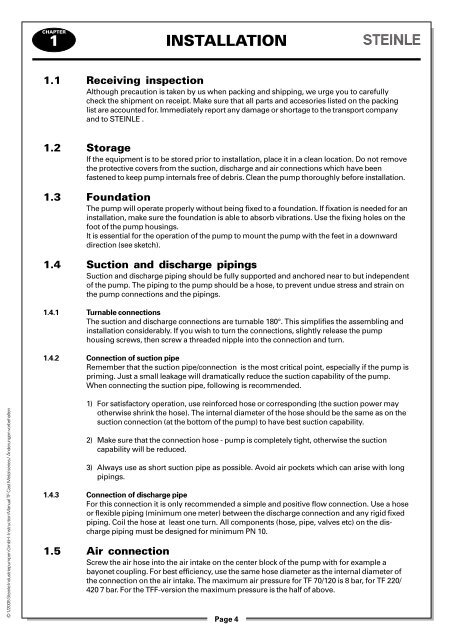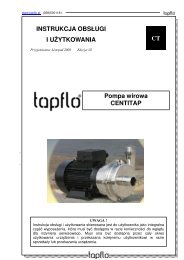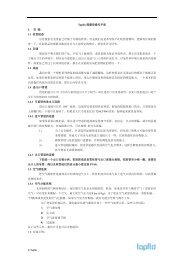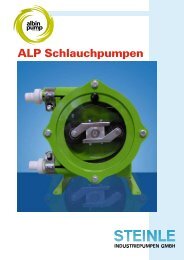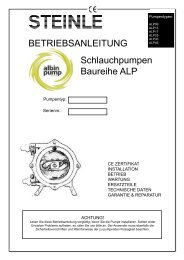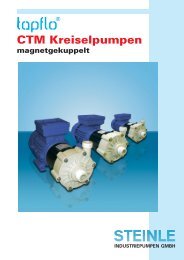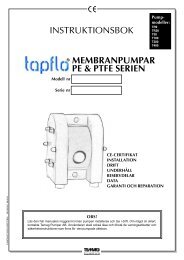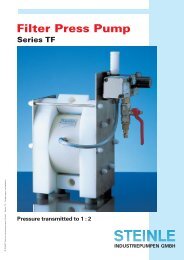1 - Steinle Industriepumpen GmbH
1 - Steinle Industriepumpen GmbH
1 - Steinle Industriepumpen GmbH
You also want an ePaper? Increase the reach of your titles
YUMPU automatically turns print PDFs into web optimized ePapers that Google loves.
1 INSTALLATION<br />
CHAPTER<br />
1.1 Receiving inspection<br />
Although precaution is taken by us when packing and shipping, we urge you to carefully<br />
check the shipment on receipt. Make sure that all parts and accesories listed on the packing<br />
list are accounted for. Immediately report any damage or shortage to the transport company<br />
and to STEINLE .<br />
1.2 Storage<br />
If the equipment is to be stored prior to installation, place it in a clean location. Do not remove<br />
the protective covers from the suction, discharge and air connections which have been<br />
fastened to keep pump internals free of debris. Clean the pump thoroughly before installation.<br />
1.3 Foundation<br />
The pump will operate properly without being fixed to a foundation. If fixation is needed for an<br />
installation, make sure the foundation is able to absorb vibrations. Use the fixing holes on the<br />
foot of the pump housings.<br />
It is essential for the operation of the pump to mount the pump with the feet in a downward<br />
direction (see sketch).<br />
1.4 Suction and discharge pipings<br />
Suction and discharge piping should be fully supported and anchored near to but independent<br />
of the pump. The piping to the pump should be a hose, to prevent undue stress and strain on<br />
the pump connections and the pipings.<br />
1.4.1 Turnable connections<br />
The suction and discharge connections are turnable 180°. This simplifies the assembling and<br />
installation considerably. If you wish to turn the connections, slightly release the pump<br />
housing screws, then screw a threaded nipple into the connection and turn.<br />
1.4.2 Connection of suction pipe<br />
Remember that the suction pipe/connection is the most critical point, especially if the pump is<br />
priming. Just a small leakage will dramatically reduce the suction capability of the pump.<br />
When connecting the suction pipe, following is recommended.<br />
© 1/2005 <strong>Steinle</strong> <strong>Industriepumpen</strong> <strong>GmbH</strong> - Instruction Manual TF Cast Metal series / Änderungen vorbehalten<br />
1) For satisfactory operation, use reinforced hose or corresponding (the suction power may<br />
otherwise shrink the hose). The internal diameter of the hose should be the same as on the<br />
suction connection (at the bottom of the pump) to have best suction capability.<br />
2) Make sure that the connection hose - pump is completely tight, otherwise the suction<br />
capability will be reduced.<br />
3) Always use as short suction pipe as possible. Avoid air pockets which can arise with long<br />
pipings.<br />
1.4.3 Connection of discharge pipe<br />
For this connection it is only recommended a simple and positive flow connection. Use a hose<br />
or flexible piping (minimum one meter) between the discharge connection and any rigid fixed<br />
piping. Coil the hose at least one turn. All components (hose, pipe, valves etc) on the discharge<br />
piping must be designed for minimum PN 10.<br />
1.5 Air connection<br />
Screw the air hose into the air intake on the center block of the pump with for example a<br />
bayonet coupling. For best efficiency, use the same hose diameter as the internal diameter of<br />
the connection on the air intake. The maximum air pressure for TF 70/120 is 8 bar, for TF 220/<br />
420 7 bar. For the TFF-version the maximum pressure is the half of above.<br />
Page 4


